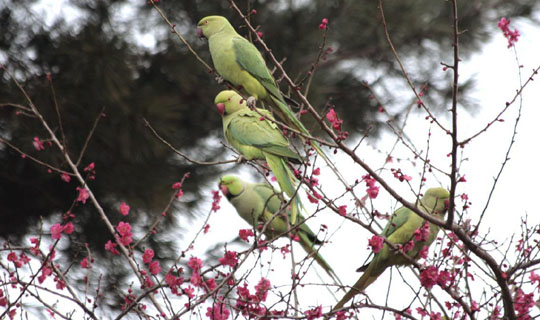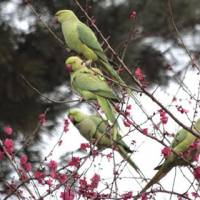Dear Alice,
Please settle an argument. I play tennis on the public courts in Arisugawa Park in central Tokyo. On several occasions I have seen bright-green noisy birds flying free around the tall outdoor lights there. I'm convinced these gregarious dandies are wild parrots. My wife says I'm out of my mind because Tokyo is way too cold for tropical birds. Can you please find out what the heck those birds are — and who the heck is right?
Ed L., Tokyo
Dear Ed,
Rather than meddle in your marriage, I'm going to take the safe route and venture that both you and your wife are almost right. The birds you spotted aren't parrots; they are parakeets. And while Tokyo is indeed too nippy for most tropical birds, these particular parakeets can handle the cold.
Those noisy green dandies are Psittacula krameri manillensis, a parakeet that is native to southern India and Sri Lanka. Its common name in English is the rose-ringed parakeet; in Japanese, it's called wakake honsei inko.
To find out why the heck birds that normally hang out near the equator are in Japan, I high-tailed it over to the Tokyo headquarters of the Japanese Society for Preservation of Birds (Nihon Chorui Hogo Renmei) and chatted with researcher Takashi Fujii. The parakeets you saw in the park, he said, are descendents of pets gone wild.
"There was a 'pet boom' in the 1960s, when many Japanese became pet owners for the first time," Fujii explained. "Large numbers of tropical birds were imported, but many weren't tame and didn't make good pets. And wakake honsei inko, in particular, are very noisy."
Some escaped. Some were lost in transit. And some were simply released by their owners when the screeching got to be too much.
By the 1980s, there were feral parakeet populations established in Tokyo, Osaka and Nagoya, as well as in Niigata and Kyushu. There are also feral rose-ringed parakeets in London, Amsterdam and a number of other cities where the birds where introduced as pets. Cold doesn't seem to be a problem; their wild counterparts are found at elevations of up to 2,000 meters in the Himalayas.
There is still a great deal that isn't known about the birds in Japan, including their diet and their effect on native birds, but at present there is little evidence to suggest they are causing harm, according to Fujii.
When I asked for a detailed description to use in my article, Fujii excused himself and came back with a plastic baggie. From it he pulled out a karihakusei, which I will translate here as "very dead bird on a skewer." (The correct term in English, I learned after picking myself up off the floor, is "study skin.")
Fujii showed how to handle the specimen by its stick, so as not to damage the feathers as it is examined. I tried very hard not to think of parakeet Popsicles as I scribbled down this description: "The wakake honsei inko is about 40 cm long, including its splendid tail feathers, and sports startlingly bright green plumage. It has a cute, short bill that is scarlet and its irises are a matching red."
When told about your inquiry, Fujii said the birds you saw are almost certainly part of a very large group that roosts every night at the Tokyo Institute of Technology. I was surprised, since the campus is eight kilometers from your tennis court as the parakeet flies, but Fujii said it's likely that the birds travel even farther to feed and breed. Then he sent me off to see for myself.
I arrived at the university in the late afternoon, well before the birds' bedtime, so I could meet first with Takehide Ikeda, a doctoral student who is helping JSPB track the parakeets' movements. This is done by capturing birds and gluing tiny transmitters onto the backs of their necks. The farthest confirmed flight is to Yamato, Kanagawa Prefecture, about 25 km from campus, Ikeda said. But he too suspects the birds' actual range is longer.
As we talked, small squadrons of rose-ringed parakeets began swooping and alighting in the treetops above our head.
"We can't say for sure, but we think it's likely that all the birds sighted around Tokyo and Kanagawa are part of this group," he explained. "The groups in other parts of Japan have apparently died out, and at the present we're only aware of this group and two much smaller ones, in Maebashi, Gunma Prefecture, and another in Chiba City."
By now, several hundred birds had arrived and the din was considerable.
"This type of parakeet roosts together, presumably because there is safety in numbers," Ikeda told me.
While the others sleep, a certain number of birds stay awake and watch for danger, like crows and hawks, and if one sounds the alarm they all take to the air together.
"The group is smaller at this time of year, because many birds are away breeding, but in spring we generally have at least 1,200 in these three trees every night," Ikeda said.
The campus is open and anyone can go in to observe the parakeets, but if you're hoping to photograph them, be aware that they time their return at dusk when it's already getting dark. Early birds can go at sunrise, when the group is just waking up and the light is better. Or take advantage of the upcoming cherry- blossom season to party with parakeets. Cherry blossoms seem to be one of the birds' favorite foods, and just like the earth-bound flocks, they turn up in numbers when the sakura are in bloom.
The Japanese Society for Preservation of Birds (Nihon Chorui Hogo Renmei) welcomes donations. Details on membership can be found (in Japanese only) on the society's Web page (www.jspb.org). Puzzled by something you've seen? Send a description, or better yet a photo, with the address where you saw it to [email protected] or Alice Gordenker, A&E Dept., The Japan Times, 4-5-4 Shibaura, Minato-ku, Tokyo 108-8071




















With your current subscription plan you can comment on stories. However, before writing your first comment, please create a display name in the Profile section of your subscriber account page.